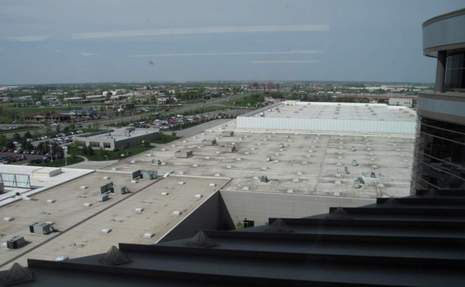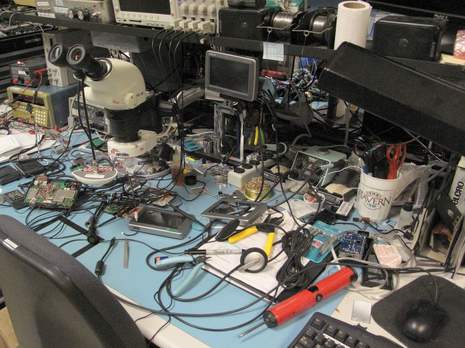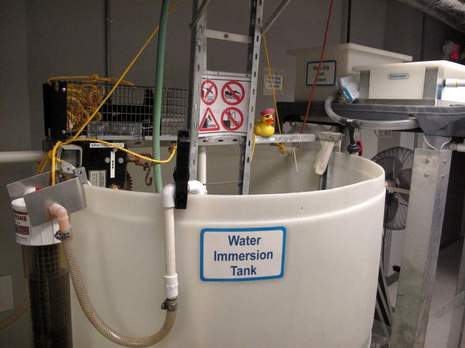Garmin visit #1, making stuff
Messy maybe, but this is how marine electronics get made, and Garmin HQ in Olathe, Kansas, is all about making stuff. The engineer who leads the hardware side of the marine department told me how his office at a previous job was two floors away from the work benches where he and his colleagues could get down and dirty with their projects. By contrast, this is just one of a dozen well-lived-in work stations on the same floor housing both marine hardware and software engineers. And that particular lead engineer has been at Garmin for 17 years, his software counterpart 16. This is a company that engineers built, and, wow, is it cooking…
I tried to capture the philosophy that led Gary Burrell and Dr. Min Kao to such success in a 2004 PMY column, and in retrospect I think I got it pretty right. But of course the revenues, building size, and much else has grown even more since then. In this view from the eighth floor of “The Tower” the original building isn’t even visible. And at left you can see just a wee corner of the latest addition — where the smartphone work is getting done. (I got a lot of hand’s-on time with the Garminfone, announced yesterday, and thought it an impressive sign of Garmin’s commitment to that bruising battle.) What you can see in this photo some four phases of warehousing now totaling some 300,000 square feet. All the aviation electronics made right here in Olathe, and all the North-America-bound gear made in Garmin’s three Taiwanese factories go through this facility. So not only is every aspect of most every Garmin product created right here, but the creators get to see the finished goods steam out the truck bays.
 Another notable aspect of the photo above is that this part of America is so flat that you can see the curve of the earth from this height. I’d read that Olathe is Swanee for “beautiful place” but when I mentioned it to one of my hosts, he suggested that perhaps those Native Americans had not gotten around much.
Another notable aspect of the photo above is that this part of America is so flat that you can see the curve of the earth from this height. I’d read that Olathe is Swanee for “beautiful place” but when I mentioned it to one of my hosts, he suggested that perhaps those Native Americans had not gotten around much. 














I think I spied a futuristic format in the photo! On the far right edge, just below the centerline, there is a futuristic looking media storage format laying on it’s edge. It appears to be platter based, rather then flash ROM based. Could this carry bluechart3? Is this a glimpse of the future at Garmin!?
The blue boards next to the screwdrivers (still in the packer I might add)?
Doesn’t look like storage to me.
-p
Ben,I was out today on a dog and pony show on a vessel I equipped that is a poster child for Garmin gear The Garmin sounder gave good depth readings at 70mph, and at slower speeds, you could see a metaphorical quarter on the bottom. The gear is great, and with each software update it gets even better. Despite this, what the owner is most impressed with is how easy is is to use. Now if they would just me the the QWERTY key board for the 5xxx series I would be a happy camper. Bill
Patrick – I thought Bob was referring to the floppy disk, you don’t see those too often these days.
Bill – Yes a mouse/keyboard interface (bluetooth?) for my 4210 would be nice. The only thing I don’t like about the 4210 is the feel of the push buttons navigating menus. 🙂
Actually, what we need now is universal remotes for marine equipment, so I can replace my wireless remote for the Garmin chartplotter, and the wireless control for my Raymarine autopilot with one waterproof wireless remote 🙂 Hmmm, maybe an Android/iPhone app?
Evan
I saw similar yesterday, Bill, over a 100nm at speeds between 40 and 60 mph, and the Garmin never lost bottom. (Though it was amazingly calm off Galveston and we never saw much more than 100 feet of depth.) The Garmin fishfinder also helped find some serious fish, which was serious fun. The day went longer than anticipated, my excuse for late update to this entry. And it’s still not all I meant.
Bill and Ben – do you know which transducer was being used to get these great images?
The Contender 32 I was on had an Airmar 1kw flush mount tilted element transducer that came out a year or so ago.
But I’ve read some posters at The Hull Truth saying that recent software updates have improved Garmin sonar a lot.
Sorry, I couldn’t help myself. Yes I was referring to the floppy disk. I have not seen one of those in a long time! So I had to make a crack.
That is really surprising and interesting that they manufacture all the avionics in the U.S. Is that a requirement for compliance with FAA? Or a requirement to get IFR certification? That probably explains why their avionics cost so much, I always assumed it was economy of scale. I guess it is probably a bit of both. If any boat owner complains about the cost of a chartplotter, check out the cost of avionics. Their g3x looks really cool, but damn, its a lot of money.
Too bad they can’t leave the handhelds GPS’s powered up when they leave the far east. It would be fun to see a tracklog of their travels to reach my local Wal-Mart or West Marine.
Ben, and Cattledog, I was also out fishing yesterday (for the very first time ever in 57 years, I will do a small post with a pic of my first fish) on a Fountain 38 CC fish, the boat I mentioned earlier. The transducer was also the same 1kw Airmar tilted element transducer. I also saw the Garmin pilot I installed operating flawlessly ar speeds of over 60mph, although I was a wee bit aprehensive. The Gulf was 1-2 foot, and the pilot ran perfectly. I understand the record speed for the pilot is 83mph. By the way, at 60mph, the boat tries to rip your clothes off, and don’t even think about keeping a hat on. Tnx Bill “White Knuckles” Bishop